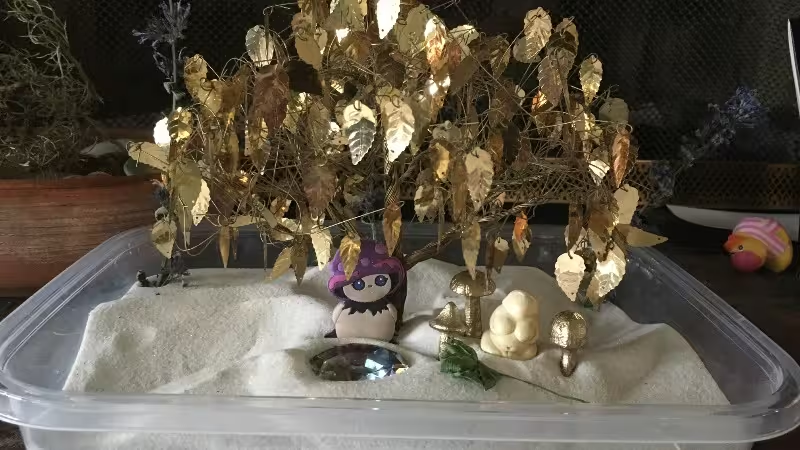Sandtray Eco-Art Therapy is an innovative therapeutic approach that integrates the principles of ecotherapy with traditional sandtray therapy. Developed by Charlton Hall, PhD, this method utilizes natural elements in the sandtray, encouraging clients to engage with the environment in a creative and healing manner. In Sandtray Eco-Art Therapy, the client uses miniature objects, often made from natural materials, to create scenes or representations in the sand, which reflect their inner thoughts, feelings, and experiences. This process allows for a deeper exploration of the self and one’s relationship with nature, facilitating emotional expression and personal growth.
Sandtray Eco-Art Therapy allows therapists who may not have access to outdoor settings for ecotherapy activities to introduce the tools of Mindfulness-Based Ecotherapy into a more traditional clinical office setting.
Charlton Hall’s development of this method emphasizes the therapeutic potential of connecting with nature, both physically and symbolically, within the safe and structured environment of the therapy session. The approach is particularly beneficial for clients dealing with trauma, anxiety, or emotional blocks, as it provides a non-verbal and tactile medium for expression (Hall, 2025).
This certification course is scheduled to be available in early 2025.
About Sandtray Eco-Art Therapy
Sandtray Eco-Art Therapy has emerged as a unique and effective approach to emotional healing and personal growth. This innovative therapy, developed by Charlton Hall, PhD, integrates the principles of traditional sandtray therapy with the healing elements of nature. By combining creative expression with an ecological perspective, Sandtray Eco-Art Therapy offers clients a powerful medium for exploring their inner worlds, addressing trauma, and fostering a deeper connection to the environment.
What is Sandtray Eco-Art Therapy?
Sandtray therapy, a form of expressive arts therapy, has been widely used for decades to help individuals express emotions and explore personal narratives through the use of miniature figures and objects placed in a tray of sand. Clients create scenes that reflect their inner thoughts, feelings, and experiences, allowing them to communicate non-verbally and access parts of the psyche that may be difficult to articulate with words alone.
Sandtray Eco-Art Therapy builds on this foundation by incorporating natural elements into the sandtray process. The “eco” aspect of the therapy emphasizes the importance of nature in the healing process, encouraging clients to use objects found in the natural world—such as stones, leaves, shells, and twigs—in their creations. This integration of natural materials not only enhances the tactile experience of the therapy but also fosters a deeper connection between the individual and the environment.
The Benefits of Sandtray Eco-Art Therapy
- Connection to Nature: One of the most significant benefits of Sandtray Eco-Art Therapy is the connection it fosters between the client and the natural world. Research has shown that spending time in nature can have profound effects on mental health, including reducing stress, anxiety, and depression (Bratman et al., 2015). By incorporating natural elements into the therapeutic process, clients can experience the calming and grounding effects of nature within the context of therapy.
- Non-Verbal Expression: For many individuals, especially those dealing with trauma or emotional blocks, finding the right words to express their feelings can be challenging. Sandtray Eco-Art Therapy provides a non-verbal outlet for these emotions, allowing clients to communicate their inner experiences through the creation of symbolic scenes in the sand. This process can be particularly helpful for children, who may find it easier to express themselves through play rather than words.
- Personal Growth and Insight: The act of creating a sandtray scene encourages introspection and self-reflection. As clients arrange objects and figures in the sand, they often gain new insights into their thoughts, behaviors, and emotions. The therapist guides this process, helping the client explore the symbolic meaning of their creations and how they relate to their life experiences. Over time, this exploration can lead to personal growth and a deeper understanding of oneself.
- Integration of Ecotherapy: Ecotherapy, or nature-based therapy, emphasizes the healing potential of the natural world. By integrating ecotherapy principles into sandtray work, Sandtray Eco-Art Therapy offers a holistic approach to healing that considers the individual’s relationship with the environment. This perspective can be particularly beneficial for clients dealing with issues related to environmental grief, climate anxiety, or a sense of disconnection from nature.
Applications of Sandtray Eco-Art Therapy
Sandtray Eco-Art Therapy can be used with a wide range of populations, including children, adolescents, adults, and families. It is particularly effective for individuals dealing with trauma, grief, anxiety, depression, and relationship issues. The therapy can be conducted in both individual and group settings, providing a versatile tool for therapists across various disciplines.
In addition to its clinical applications, Sandtray Eco-Art Therapy can also be used in educational settings, community programs, and environmental organizations. For example, schools may incorporate Sandtray Eco-Art Therapy into their counseling programs to help students manage stress and develop emotional resilience. Environmental groups may use the therapy to help individuals process feelings of loss and grief related to environmental destruction.
Sandtray Eco-Art Therapy represents a powerful fusion of traditional therapeutic practices and the healing potential of nature. By providing a non-verbal medium for expression and fostering a deeper connection to the natural world, this therapy offers a unique and effective approach to emotional healing and personal growth. As more therapists and clients discover the benefits of Sandtray Eco-Art Therapy, it is likely to become an increasingly important tool in the field of mental health.
References:
Bratman, G. N., Hamilton, J. P., Hahn, K. S., Daily, G. C., & Gross, J. J. (2015). Nature experience reduces rumination and subgenual prefrontal cortex activation. Proceedings of the National Academy of Sciences, 112(28), 8567-8572.
Hall, C. (2025). Sandtray Eco-Art Therapy. Elder Grove Media.

